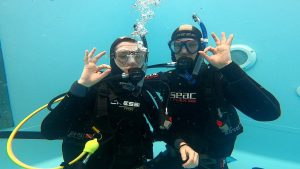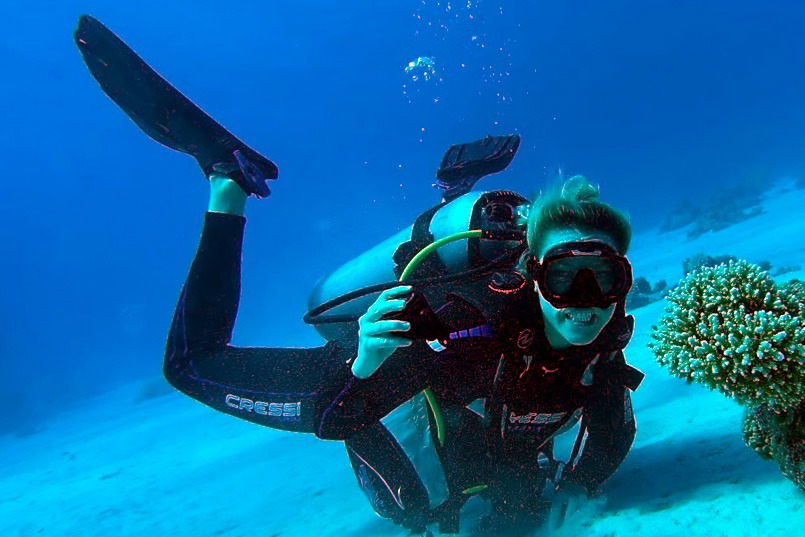Removing the diving regulator underwater is an intentional air cutoff. A PADI instructor trainer's perspective on this issue. In the field of diving, a breathing regulator is an indispensable piece of equipment, providing life-sustaining air to the underwater diver.

In diving courses "PADI Open Water", students often wonder if a diver should remove the regulator from the mouth underwater, causing debate among both experienced divers and novice divers. This article explores these nuances by exploring the technical aspects, safety considerations, and expert opinions related to removing a diving regulator underwater.
Table of Contents
Technical information on the construction of the diving regulator
A diving regulator consists of several main components, each of which plays a critical role in supplying air to the diver's lungs.
- The first stage regulator, located on the scuba tank, reduces the high pressure air from the tank to a lower pressure suitable for inhalation.
- A second-stage regulator attached to the mouthpiece further reduces pressure and regulates the flow of air to the diver's lungs through the mouth.
- In addition, the demand valve mechanism ensures that air is only supplied when the diver inhales, preventing accidental overpressurization.

Safety Considerations: Weighing the Risks and Benefits
Although there may be occasions when the regulator must be removed from the mouth, such as to clean the mask or communicate with another diver, this is generally considered a risky practice. The main concern is the possibility of the diver losing access to air, which can lead to hyperventilation, panic, or even drowning. Additionally, removing the regulator increases the risk of water entering the lungs, known as pulmonary edema. This condition can be severe and even fatal.
Opinion from an expert in the scuba industry: PADI instructor instructions

"In my experience as a PADI instructor, informs Valters Preimanis, PADI MSDT instructor, I have constantly advised my students to avoid taking the regulator out of their mouth underwater, unless absolutely necessary. The risks simply outweigh the benefits. There are alternative methods for performing tasks such as communication or clearing the mask. "Do not compromise the diver's air supply or safety.“
Five key questions and answers
1. Question
What are the potential risks associated with removing a diving regulator underwater?
Answer: The main risks include loss of air access, the onset of hyperventilation or panic, and an increase in water entering the lungs (pulmonary edema).
2. Question
When is it safe to remove the regulator underwater?
Answer: In the hands of experienced divers, it may be acceptable to remove the regulator for short periods under controlled conditions, such as cleaning the mask or communicating with a nearby partner. However, continuous removal or removal under difficult conditions is not recommended.
3. Question
What are alternative methods for performing tasks such as communication or clearing the mask without removing the regulator?
Answer: Hand signals or voice amplification devices can be used in different ways for communication. To clear the mask, they can tilt their head back and blow gently through their nose.
4. Question
How can divers safely remove and replace a regulator underwater?
Answer: To remove the regulator, exhale fully and slowly lift it out of your mouth, ensuring a tight seal around the mouthpiece. To replace, align the mouthpiece with your mouth and gently push it in with a deep breath to make sure it is properly sealed.
5. Question
What are the main factors to consider when determining whether a regulator should be removed underwater?
Answer: The diver's experience level, diving depth, surrounding environment and specific task should be carefully evaluated before deciding to remove the regulator.
"PADI Open Water" exercise, removing the regulator from the mouth underwater
- PADI offers several exercises to help you learn how to safely remove and insert a breathing regulator underwater. One exercise is remove the regulator without stopping exhalation. To do this, the diver initially puts the regulator in the mouth and then inhales.
- The diver then gradually removes the regulator from the mouth while continuing to breathe. This helps the diver learn the techniques of removing and inserting the regulator without holding their breath, which is important to avoid panic or hyperventilation.
- Another exercise is remove the regulator and then put it back. To do this, the diver initially puts the regulator in the mouth and then inhales. He then gradually removes the regulator from the mouth until it is completely removed. Then he puts the regulator back in his mouth, making sure it fits snugly. This exercise helps the diver learn the techniques of removing and inserting the regulator while focusing on keeping the regulator tight.
- PADI also recommends that divers practice removing and inserting the regulator in different situations, such as when diving with oxygen or diving with other divers. This helps the diver prepare for various possible situations that may occur underwater.
In conclusion, although there may be rare circumstances where removing a regulator underwater is unavoidable, it is generally considered a risky practice. Divers should prioritize safety and avoid removing the regulator unless absolutely necessary.
Alternative methods exist for tasks such as communication or clearing the mask and should be used whenever possible. Remember that safety is paramount in scuba diving and always exercise caution.

